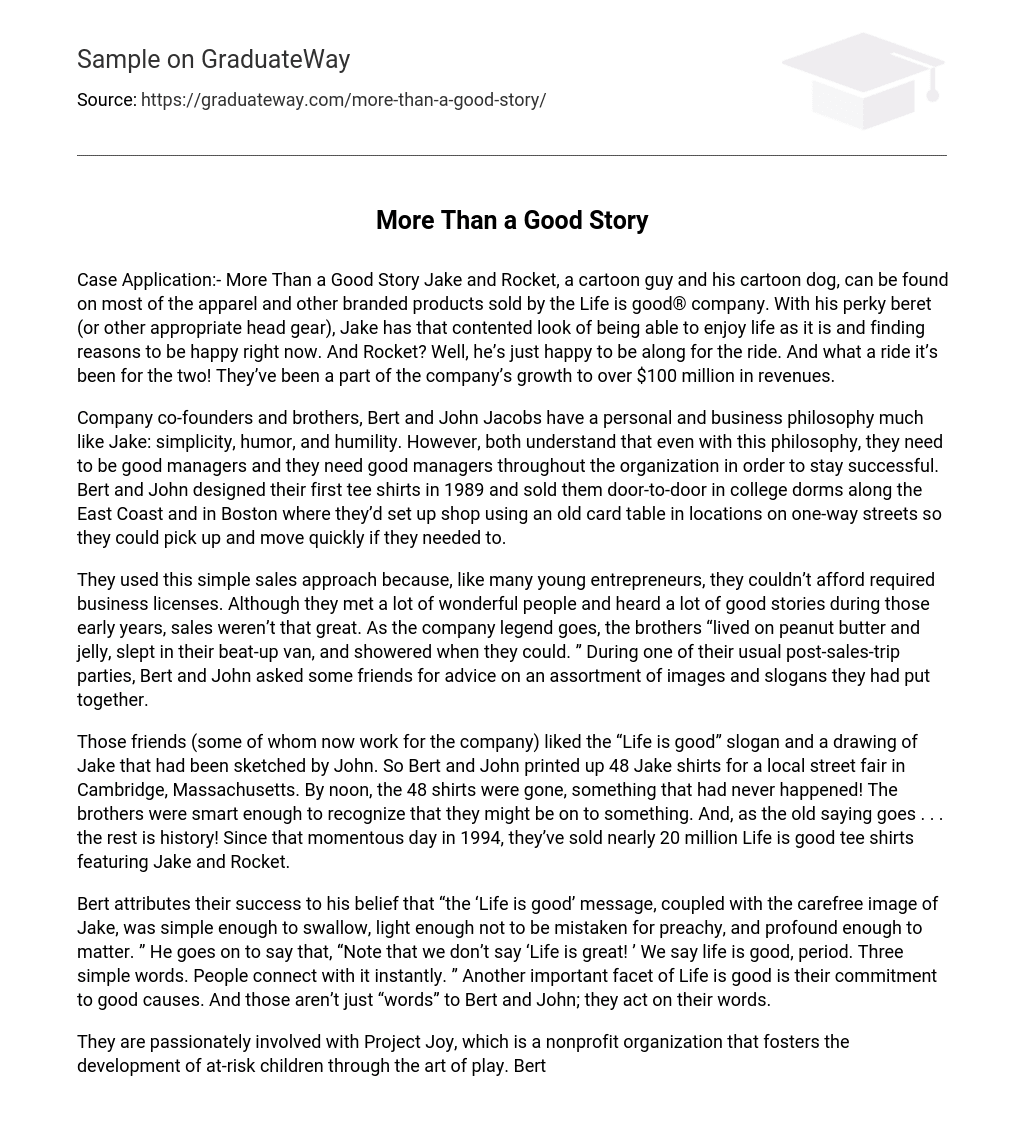Jake and Rocket, a cartoon guy and his cartoon dog, can be found on most of the apparel and other branded products sold by the Life is good® company. With his perky beret (or other appropriate head gear), Jake has that contented look of being able to enjoy life as it is and finding reasons to be happy right now. And Rocket? Well, he’s just happy to be along for the ride. And what a ride it’s been for the two! They’ve been a part of the company’s growth to over $100 million in revenues.
Company co-founders and brothers, Bert and John Jacobs have a personal and business philosophy much like Jake: simplicity, humor, and humility. However, both understand that even with this philosophy, they need to be good managers and they need good managers throughout the organization in order to stay successful. Bert and John designed their first tee shirts in 1989 and sold them door-to-door in college dorms along the East Coast and in Boston where they’d set up shop using an old card table in locations on one-way streets so they could pick up and move quickly if they needed to.
They used this simple sales approach because, like many young entrepreneurs, they couldn’t afford required business licenses. Although they met a lot of wonderful people and heard a lot of good stories during those early years, sales weren’t that great. As the company legend goes, the brothers “lived on peanut butter and jelly, slept in their beat-up van, and showered when they could. ” During one of their usual post-sales-trip parties, Bert and John asked some friends for advice on an assortment of images and slogans they had put together.
Those friends (some of whom now work for the company) liked the “Life is good” slogan and a drawing of Jake that had been sketched by John. So Bert and John printed up 48 Jake shirts for a local street fair in Cambridge, Massachusetts. By noon, the 48 shirts were gone, something that had never happened! The brothers were smart enough to recognize that they might be on to something. And, as the old saying goes the rest is history! Since that momentous day in 1994, they’ve sold nearly 20 million Life is good tee shirts featuring Jake and Rocket.
Bert attributes their success to his belief that “the ‘Life is good’ message, coupled with the carefree image of Jake, was simple enough to swallow, light enough not to be mistaken for preachy, and profound enough to matter. ” He goes on to say that, “Note that we don’t say ‘Life is great! ’ We say life is good, period. Three simple words. People connect with it instantly. ” Another important facet of Life is good is their commitment to good causes. And those aren’t just “words” to Bert and John; they act on their words.
They are passionately involved with Project Joy, which is a nonprofit organization that fosters the development of at-risk children through the art of play. Bert says their partnership with Project Joy aligns with Life is good’s whole philosophy. The financial commitment the company has made is supported by its Life is good Kids Foundation, which raises funds through the popular Life is good festivals and through sales of fundraising t-shirts and books at its retail stores.
Today, Life is good, based in Boston, has a product line of more than 900 items. The company continues to grow about 30 to 40 percent annually. Bert and John’s style of managing is guided by another of the company’s mottoes, “Do what you like. Like what you do. ”® As the company’s Web site states, “In addition to knowledge, skills, and experience, we look to hire people who possess the same optimistic outlook on life that Jake has. ” It’s an approach that seems to be working for Bert and John and for Jake and Rocket.
Discussion Questions
- As the top managers of their company, what types of issues might Mr. Bert and Mr. John have to deal with? Be as specific as possible. Which management functions might be most important to them? Why?
- Using descriptions from the case, describe Mr. Bert and Mr. John’s managerial style. Would this approach work for other organizations? Why or why not?
- How do you think the company’s motto “Do what you like. Like what you do” might affect how managers manage? Be specific.
- What managerial challenges might there be in having friends work for your business? How could these challenges be kept inconsequential?
- Would you want to work for a company like this? Why or why not?
- In what ways would the Life is good managers (corporate and retail store) have to deal with the challenges of customer service, innovation, and sustainability? Be specific in your description.
- How does the organization cater social responsibility?
Source
- Stephen P. Robbins, Mary Coulter. , Management 11th Ed.





